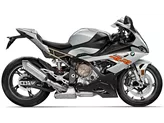BMW S 1000 RR 2017 vs. Yamaha R1 2018

BMW S 1000 RR 2017

Yamaha R1 2018
Overview - BMW S 1000 RR 2017 vs Yamaha R1 2018
The BMW S 1000 RR model year 2017 and the Yamaha R1 model year 2018 are both high-performance supersport motorcycles that offer impressive specifications and features.
Starting with the engine and drive train, both motorcycles have a 4-cylinder engine with a displacement of around 1000cc. The BMW S 1000 RR has a bore of 80mm and a stroke of 49.7mm, while the Yamaha R1 has a slightly smaller bore of 79mm and a stroke of 50.9mm. In terms of power, the BMW S 1000 RR offers 199 HP, slightly lower than the 200 HP of the Yamaha R1. Both motorcycles have a compression ratio of 13 and 4 valves per cylinder. The torque of the BMW S 1000 RR is 113 Nm, while the Yamaha R1 has a torque of 112.4 Nm.
When it comes to suspension, both motorcycles feature upside-down telescopic forks at the front. The chassis of both bikes is made of aluminum, providing a lightweight and rigid structure. The BMW S 1000 RR has a twin-tube frame, while the Yamaha R1 features a Deltabox frame.

BMW S 1000 RR 2017
In terms of braking, both motorcycles have double disk brakes at the front. The dimensions and weights of the front and rear tires are the same for both bikes, with a width of 120mm and a diameter of 17 inches. The wheelbase of the BMW S 1000 RR is slightly longer at 1438mm compared to the 1405mm of the Yamaha R1. The seat height of the BMW S 1000 RR is 815mm, while the Yamaha R1 has a higher seat height of 855mm. The kerb weight of the BMW S 1000 RR is 208kg, slightly heavier than the 199kg of the Yamaha R1. Both motorcycles have a fuel tank capacity of around 17 liters.
Moving on to the strengths of each motorcycle, the BMW S 1000 RR 2017 offers a complete electronic equipment package on request, providing advanced features and technology. The engine of the BMW is powerful and easy to control, offering a strong performance. The seating position of the BMW S 1000 RR is comfortable, even for taller riders. The chassis of the BMW S 1000 RR performs well both on the road and at track days.
On the other hand, the Yamaha R1 2018 has a very rev-happy engine and produces a great sound. The handling of the Yamaha R1 is terrific, allowing for agile and precise maneuvers. Despite its compact and radical design, the Yamaha R1 offers great seating comfort. The electronic equipment of the Yamaha R1 is of high quality, providing advanced features. The components of the Yamaha R1 are also high-quality and made with modern manufacturing methods.

Yamaha R1 2018
However, both motorcycles have their weaknesses. The BMW S 1000 RR 2017 may experience brake fade under high load on the racetrack. While the ride quality of the BMW S 1000 RR is sufficient for track days, it may not be as good for racing. Additionally, some may find the appearance of the BMW S 1000 RR to be dull, despite its up-to-date technology.
On the other hand, the Yamaha R1 2018 requires an agile driving style and may not be as comfortable for casual cruising.
In conclusion, both the BMW S 1000 RR 2017 and the Yamaha R1 2018 offer impressive performance and features. The BMW S 1000 RR excels in terms of electronic equipment and comfort, while the Yamaha R1 shines with its rev-happy engine, handling, and high-quality components. However, the BMW S 1000 RR may suffer from brake fade and has a less appealing appearance, while the Yamaha R1 requires a more aggressive riding style.
Technical Specifications BMW S 1000 RR 2017 compared to Yamaha R1 2018
Pros and Cons in comparison
Pros and Cons in comparison
BMW S 1000 RR 2017

Ce talent universel et équilibré restera en tête de nombreux tests comparatifs en 2017. Elle marque toujours des points grâce à son moteur exceptionnel et à ses caractéristiques universelles et complètes.
Yamaha R1 2018

La Yamaha YZF-R1 est plus proche que jamais d'une machine de course. Le moteur brille par sa légèreté et son agilité. La position de conduite surprend positivement et la maniabilité est radicale mais toujours "adaptée à la masse". La machine attire immédiatement l'attention, tant par son aspect que par sa sonorité qui fait chaud au cœur. 20 ans après la première R1, elle est désormais le plus grand jalon de l'histoire de la R1.
Price Comparison Avarage Market Price BMW S 1000 RR vs Yamaha R1
There are a few key differences between a BMW S 1000 RR 2017 and a Yamaha R1 2018. There are the same number of bikes of both models available on the 1000PS.de marketplace, specifically 9. It takes less time to sell a Yamaha R1 with 52 days compared to 96 days for the BMW S 1000 RR. Since model year 2010 1000PS.de editors have written 135 reviews for the BMW S 1000 RR and 80 reviews for the Yamaha R1 since model year 2005. The first review for the BMW S 1000 RR was published on 4/16/2008 and now has more than 4,000 views. This compares to more than 3,900 views for the first review on Yamaha R1 published on 4/28/2003.




















